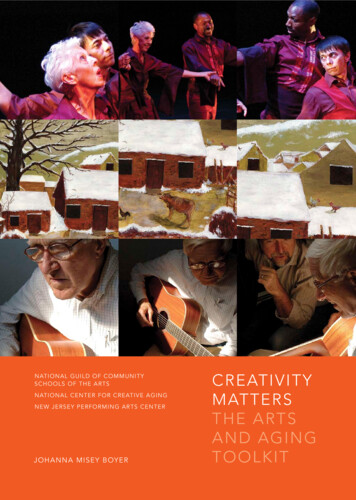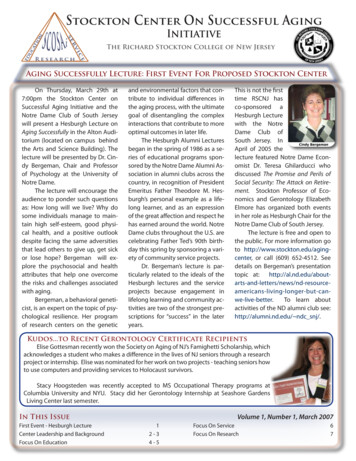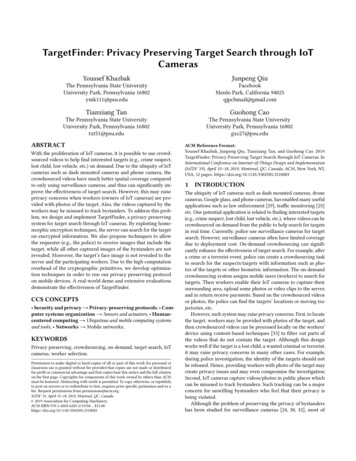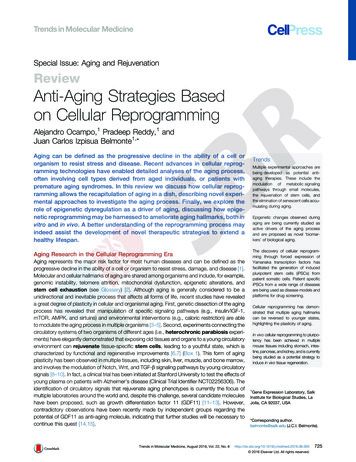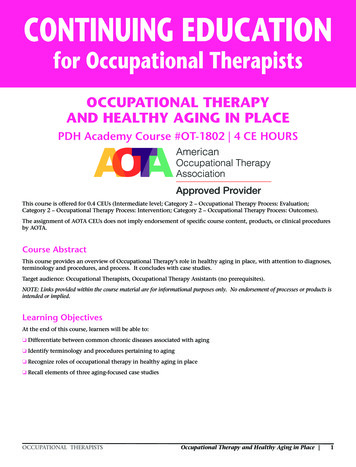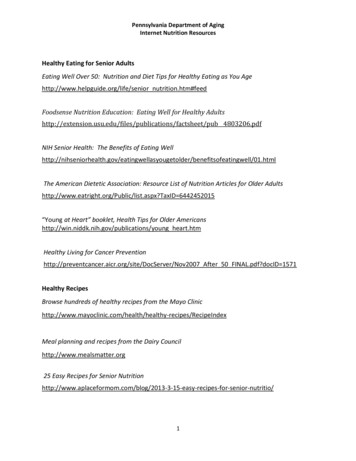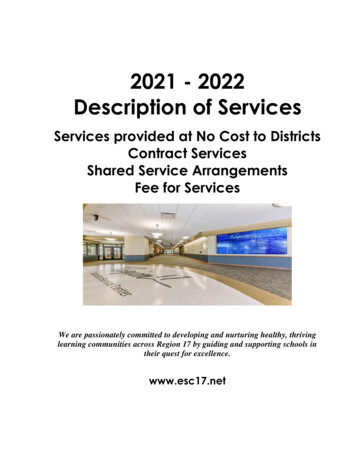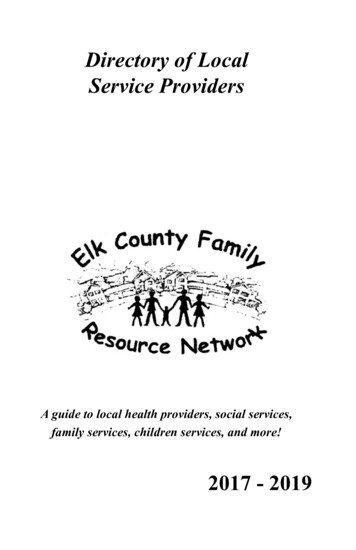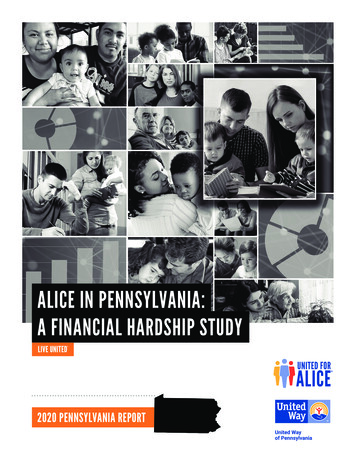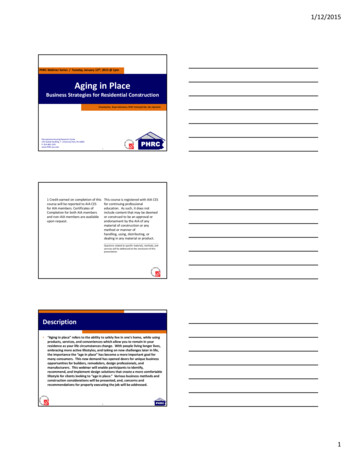
Transcription
1/12/2015PHRC Webinar Series / Tuesday, January 13th, 2015 @ 1pmAging in PlaceBusiness Strategies for Residential ConstructionPresented by: Bryan Heitzmann, PHRC Training & Edu. Dev. SpecialistPennsylvania Housing Research Center219 Sackett Building University Park, PA 16802P: 814‐865‐2341www.PHRC.psu.edu41 Credit earned on completion of thiscourse will be reported to AIA CESfor AIA members. Certificates ofCompletion for both AIA membersand non‐AIA members are availableupon request.This course is registered with AIA CESfor continuing professionaleducation. As such, it does notinclude content that may be deemedor construed to be an approval orendorsement by the AIA of anymaterial of construction or anymethod or manner ofhandling, using, distributing, ordealing in any material or product.Questions related to specific materials, methods, andservices will be addressed at the conclusion of thispresentation.5Description “Aging in place” refers to the ability to safely live in one’s home, while usingproducts, services, and conveniences which allow you to remain in yourresidence as your life circumstances change. With people living longer lives,embracing more active lifestyles, and taking on new challenges later in life,the importance the “age in place” has become a more important goal formany consumers. This new demand has opened doors for unique businessopportunities for builders, remodelers, design professionals, andmanufacturers. This webinar will enable participants to identify,recommend, and implement design solutions that create a more comfortablelifestyle for clients looking to “age in place.” Various business methods andconstruction considerations will be presented, and, concerns andrecommendations for properly executing the job will be addressed.61
1/12/2015Learning Objectives Following the completion of this webinar, participantswill be able to:– Describe methods of performing a needs assessment to identify andbalance the safety and essentials required by the client– Determine design solutions for various rooms of a home that will meet andsatisfy the needs of the Aging in Place client– Determine the primary decision maker when conducting business on an“aging in place” project– Recognize specific design solutions for the client and understandconsiderations for executing the job while the client is in the home7Agenda Background Markey Characteristics Assessing the Job Scheduling the Job Executing the Job Design Solutions Summary & Questions8Background92
1/12/2015Background What is Aging in Place?– A term used to describe a person living in theresidence of their choice, for as long as they areable, as they age– The concept of adapting your home and lifestyleto provide a safe and healthy living environmentas you age– Includes being able to have any services orsupport systems needed over time as occupantneeds change10Background ‐ Market The Aging in Place market is characterized byneeds/wants that develop from the aging process– Planning for changes that will occur due to aging & whatimpacts these changes will have on their lives– Not just for senior citizens– For those who want to maintain their current quality of life Planning presents an opportunity to lessen the burdenby:– Outlining how and where needs will be met– Lessening the need for assistance from family, neighbors,or community resources11Market Size The percentage of older Americans continuesto rise dramatically– Healthier lifestyles– Specialized medicines– Increased technology– Focused careReasons for increased life expectancy– People are living longer 1987 life expectancy 74.77 2012 life expectancy 78.74123
1/12/2015Market size ‐ Baby Boomers Baby Boomer Generation– Born from 1946 to 1964– Boomers make upapproximately 25% of thetotal U.S. population– Approximately two‐thirdsof all seniors 65 and overhave at least one chronicdiseaseU.S. Births By Year In Thousands–CNN.comUS Dept. of Commerce, Bureau of the Census– National Center for Health Statistics13Why is it “Important” Represents business opportunity– Home modifications to meet client needs– Building “aging ready” homes– Consulting Training is key element– Technical– Business management– Customer service skills14Program Objectives To present various methods and techniques formodifying a home design– New Construction– Remodel– Retrofitting Provide knowledge to the builder/remodeler ofpotential client needs– Current and projected needs based on client154
1/12/2015Program Objectives Allow participants to:– Identify– Recommend– OfferEffective design solutions forthe Aging in place client Methods of performing a needs based assessment for an aging inplace client Understand affordability considerations and concerns associatedwith aging in place clients Create a safe and comfortable environment for individuals seekingthat “age in place”16Market Characteristics17Increasing Market Size The percentage of older Americans has increasedsignificantly– 15.3% increase in 65 population from 2000 ‐ 2010– Currently 13.7% of Americans are ages 65 and older– By 2030, he 65 population segment is projected to be72 million Projections show 18% will be 65 and older– People are living longer 1987 life expectancy 74.77 2012 life expectancy 78.74US Dept. of Commerce, Bureau of the Census185
1/12/2015Market size ‐ National19Market Size ‐ National20Market Size ‐ Pennsylvania AGE 60 YEARS & OLDER :– 2020 ESTIMATE: 25 % of the totalpopulation (3.3 MILLION )– 2030 ESTIMATE: 28 % of the totalpopulation (3.6 MILLION )Source: US Census216
1/12/2015Pennsylvania VS.USAPopulation: 2012 estimateSource: US Census ALL AGES:– PA:12.76 MILLIONUSA:313.9 MILLION AGES 50‐64 YEARS OLD :– PA: 21% (2.69 MILLION)USA: 19.5% (61.16 MILLION) AGES 65 YEARS OLD & OLDER:– PA: 16% (2.04 MILLION)USA: 13.7% (43.15 MILLION)22Three Market Segments Aging in Place:1) Without urgent needs2) With progressive condition based needs3) With traumatic change needs23Market Design CategoriesAging in Place Design Strategies247
1/12/2015Market Design Services25Market Appeals Desire to remain in their current home as long aspossible– 91% of pre‐retirees (50 to 65) responded that they want tolive in their own homes in retirement Of that group:– 49 percent want to stay in their current homes– 38 percent want to move to new homesMetLife Marketing Institute Even if day‐to‐day assistance or ongoing health care isneeded during retirement:– 82% would prefer to stay in their homes– Only 9% express a preference for moving to a facilitywhere care is provided– Only 4% prefer moving to a relative’s home– aarp.org26Market Appeals Social attachments– Friends– Neighbors– FamilyProvide support that help people remainactive and independent within a community Many organizations are using housing as aplatform to provide supportive services that adaptto the needs of seniors– Allowing them to remain at home and continue toengage with their communities‐ HUD278
1/12/2015Market Opportunity Represents large market opportunity– The NAHB predicts that aging in place remodelingmarket to be 20‐ 25 billion– Most existing homes were build without regard forUniversal Design Accessibility Visitability Adaptability– 45% of homeowner remodeling spending is bypersons who are 50 or older‐ Joint Center for Housing Studies (JCHS)28– Clients will have immediate and expanding needsAssessing the Job30Determining the Decision Maker Who is the “decision maker?”– Spouse– Adult child– Companion– Case manager– Healthcare professionalNot always the client who isrequiring the necessary homemodifications Client may not always be able to make decisionsregarding care or lifestyle changes needed319
1/12/2015Determining the Decision Maker It is important to be clear on who is the ultimatedecision maker– If possible, involve all parties in the process– Be clear with all parties on expectationsPotential Decision Makers Spouse/Significant other/Guardian– Often primary caregiver– Best source of unbiased information– Potential concerns Financial Lifestyle32Determining the Decision Maker Adult Children– Great source of information– Often not living in the home Time constraints Job intentions Financial intentions Others– Influencers Friends/distant family Service providers– Be aware of any hidden agendas Clients home Clients money33Other Decision Makers Others ‐ Partnership– Health Care Professionals (HCP) Occupational TherapistsPhysical TherapistsSocial WorkersCase ManagersNurses Can provide detailed client prognosis– Recommend appropriate needs based solutions Mobility issues Progressive needs3410
1/12/2015Assessing the Client Focus should be on providing clients with safer and moreaccessible living environments– Needs will vary depending the client’s impairment requirements Incorporate Universal Design and Aging‐in‐Place principlesinto home modifications– Retain home’s market value Aging in place is a choice to ensure a higher quality of lifeand attempt to control aging related circumstances withinthe home35Client Impairment Categories Aging in Place:1) Without urgent needs2) With progressive condition based needs3) With traumatic change needs36Assessing Client Impairments Mobility and Ambulatory Considerations– Canes Used by clients who require increased stability– Walkers Clients with difficulty walking– Wheelchairs Manual Wheelchairs Power WheelchairsWidth concerns for interior spaces– Scooters37 Turning radius Pivoting seat11
1/12/2015Assessing Client Impairments Sensory impairment needs– Sight Cataracts, Glaucoma– Hearing Conductive hearing loss vs. Sensorineural hearing loss– Touch Peripheral neuropathy– Taste Loss of taste– Smell Loss of smell38Assessing Client Impairments Cognitive impairments– Orientation The ability to correctly identify surroundings– Who, where, when– Alertness Being mentally responsive and perceptive– Memory Memory loss– Short‐term vs Long‐term39Home Audit Pair client assessment witha “home audit”– Gathering of pertinent dataregarding livingaccommodations Floor plan Area dimensions Area limitations Results in an effectiveclient evaluation– Determine “scope of work”4012
1/12/2015Possible Funding Sources There are 4 different types of assistance for pment loans Loans– Banks– Equity Owners have built large amounts of equity in their current homes Equity helps with affordability concerns for financing the project41Possible Funding Sources Grants– One‐time for a specific home modification purpose& do not need to be re‐paid Medicaid HCBS waivers and home modifications– Pennsylvania Department of Aging Medicaid Waive– Pennsylvania Services My Way (SMW) Program Veterans programs for home modifications Non‐Medicaid govt. assistance for home modifications– HUD Home Improvement Loans42Possible Funding Sources Free Labor Programs– Organizations offer free labor for home improvements Non‐Profit & Foundation Assistance for Home Modifications– Rebuilding Together (originally called Christmas in April)– Veterans volunteer programs – “Heroes at Home” Equipment Loans– Organizations making free, long term loans of homemodification equipment to the elderl May lend a senior a removable wheelchair ramp that does notneed to be returned until the senior moves from the home & nolonger requires use of the ramp4313
1/12/2015Scheduling the Job44Scheduling Considerations Aging in place jobs require a different jobscope than traditional modifications– Client is usually living in the home wheremodifications are being done– The client may require special needs regarding: Cleanliness Climate control Accessibility– May result in fragmented work process45Job Scope The division of work to be performed under a contractor subcontract in the completion of a project, typicallybroken out into specific tasks with deadlines– Business Dictionary Additional importance on scope of work in aging inplace projects––––Nature of clients disabilityFunding considerationsDiscussion with specific material providersMedical or mobility concerns4614
1/12/2015Equipment Installation Equipment for aging in place clients with traumaticcondition often must be installed by specialists Equipment is often new to the market and mayrequire longer periods of time to ensure properinstallation Allow proper time for proper equipment training tooccur with the aging in place client Equipment installation is often a team effort47Schedule Constraints Overall, make sure to build in extra time or give specialconsideration to planning aging in place projects when youcreate the job scope– Sales process– Financing process– Construction process Special considerations––––Working bathroomDustDebris removalLack of heating/cooling48Executing the Job4915
1/12/2015Building Around the Client Take extra precaution to protect the safety ofthe client based on their needs– Kitchens– Bathrooms– BedroomsConsider client routines regarding daily activity Possibly only one usable bathroom for the client Does project require the client to seek temporaryaccommodations Mobility issues of the client being affected50Building Around the Client Considerations:– Protective floor material that will not affect the client’smobility– Plastic room dividers to prevent dust transfer– Promptly remove construction debris to minimize risk– Use a portable air filter– Block return vents– Temporary bathrooms that meet client needs51**May seem obvious, but these types of concernsrequire extra consideration on Aging in Place jobs**Communication Make sure to communicate with the client anddecision make often– Often the first time remodeling process has takenplace for the client– Set proper expectations– Discuss the project throughout Features and benefits of upgrades Make sure everyone working on the project isaware of the nature of the job taking place5216
1/12/2015Post Completion Thoroughly explain any additional costs that occurredduring the construction process– Also of any future changes if a return trip is required Provide necessary client training of all necessary devicesinstalled– Have supplier explain specialized equipment Provide contact names for contractors and equipment forservice requirements– Leave any manuals or manufacturer’s instructions with the client53Design Soultions54Home Design Solutions The can be implemented:– Entrance– Visual enhancements– Windows and doors– Flooring– Lighting– Kitchens– Bathrooms5517
1/12/2015Aging in Place Products Everyday products for you home that makeaging in place easierLifting TablesLarge ButtonsTouch ScreensKeyless Entry56Remote ControlsOrganization & ShelvesEssential Design SolutionsSource: NAHB, What Home Buyers Really Want Survey Results, Released May 201357Summary5818
1/12/2015Summary Aging in Place is:– A term used to describe a person living in the residence of their choice,for as long as they are able, as they age– The concept of adapting your home and lifestyle to provide a safe andhealthy living environment as you age The percentage of older Americans has increased significantly– Baby Boomers– Life expectancies Represents business opportunity– Home modifications to meet client needs– Building “aging ready” homes– Consulting59Summary Assessing the job– Who is the “decision maker?”– Focus should be on providing clients with saferand more accessible living environments– Clients will be:1)2)3)Without urgent needsWith progressive condition based needsWith traumatic change needs60Summary Clients can have:– Mobility and Ambulatory Considerations– Sensory impairment needs– Cognitive impairments Pair client assessment with a “home audit”– Result be an effective scope of work Aging in place jobs require a different job scope thantraditional modifications– Building around the client and their needs More time necessary6119
1/12/2015Summary Extra consideration must be given to the Scope of Work ifequipment is to be installed During construction, take extra precaution to protect thesafety of the client based on their needs Make sure to communicate with the client and decisionmake often– Set proper expectations– Discuss the project throughout Design Solutions6220
1/12/2015 5 Program Objectives Allow participants to: - Identify - Recommend - Offer Methods of performing a needs based assessment for an aging in place client Understand affordability considerations and concerns associated with aging in place clients Create a safe and comfortable environment for individuals seeking
